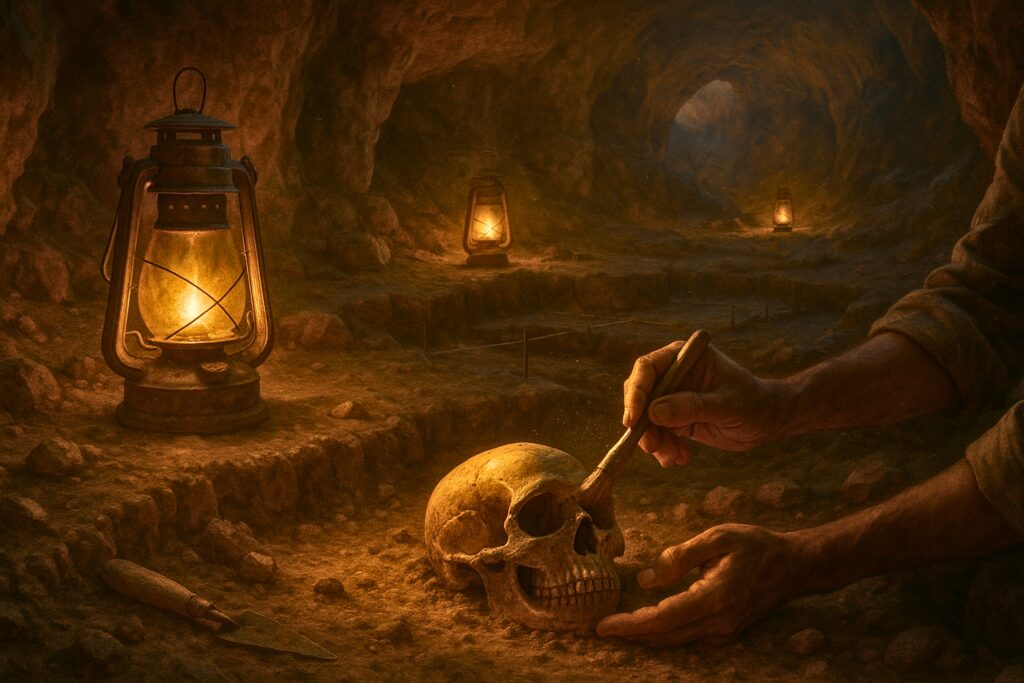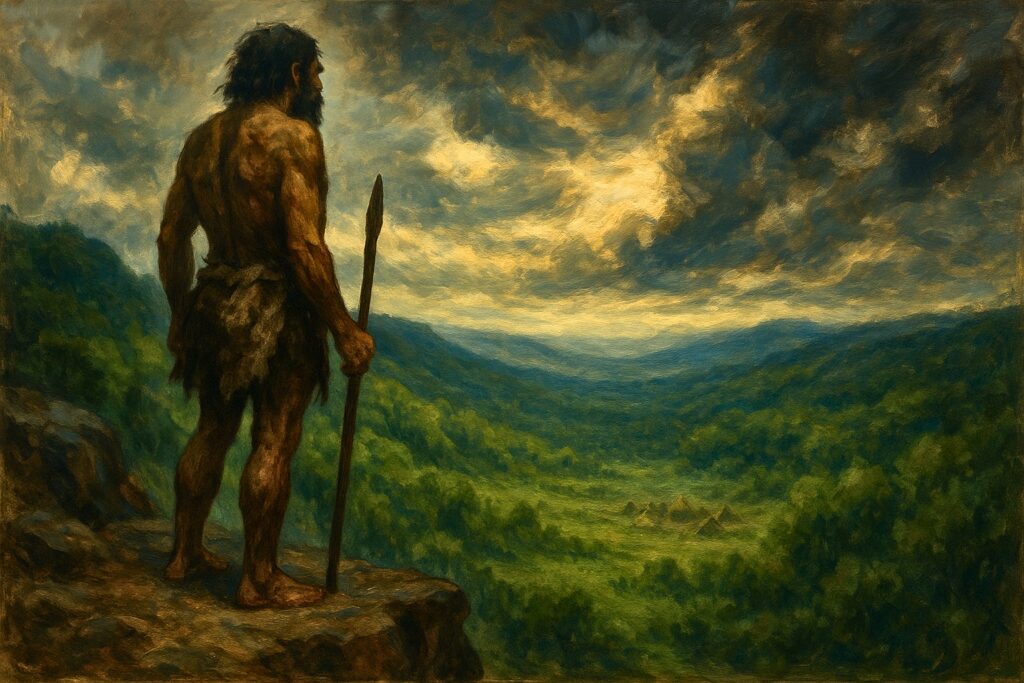What if the story we tell ourselves about us is wrong? Not just slightly off, not just missing a few details, but fundamentally mistaken in its very first chapter. For decades, we held a comfortable image of our origins. We pictured the birth of Homo sapiens in a specific corner of Africa, a spark of consciousness igniting around 180,000 years ago. It was a simple, linear tale of progress.
But what if a discovery, unearthed from a dusty hillside in Morocco, quietly tells us that the reflection staring back from the mirror is at least 100,000 years older than we ever imagined?
This isn’t a thought experiment. This is the reality handed to us from a place called Jebel Irhoud. The discovery of 315,000-year-old Homo sapiens fossils there didn’t just add a new entry to a textbook; it presented a profound challenge to our entire narrative of human becoming. It’s easy to update a date on a timeline.
“The far harder, and more necessary, task is to update the story.”
If our species is so much older, then our journey has been far longer and stranger than we know. And it forces us to ask a question that echoes from that ancient Moroccan cave: If we have been here for so long, what were we doing all that time?
What were the oldest Homo sapiens fossils before Jebel Irhoud?
Before the Jebel Irhoud fossils came to light, the story of our species felt complete, almost tidy. The oldest known remains of Homo sapiens were found in Ethiopia and dated to between 160,000 and 195,000 years ago. This placed our emergence neatly within a specific window of opportunity, a single chapter in Earth’s climatic history.
We imagined our ancestors arising, blinking in the African sun, just before the last great warming period. They were the “anatomically modern humans” who would, in a relatively short span of geological time, develop complex tools, create art, and spread across the globe.
“It was a story of a single, successful push.”
The Shattering of a Comfortable Timeline
Then came the revelations from Jebel Irhoud. The site, a former barite mine, had yielded fossils before, but new dating techniques applied to unearthed flint tools and a newly discovered skull changed everything. The results were staggering: these early Homo sapiens lived and died approximately 315,000 years ago.
These were not our evolutionary cousins. They had the familiar, modern face of our own species. Their braincases were slightly more elongated, a subtle variation on a theme, but the message was clear. We were here. We were looking out at a world that we, in our modern arrogance, had assumed was empty of us. The discovery shifted the cradle of humanity from a single East African origin to a pan-African phenomenon. The story was no longer linear; it was a vast, sprawling epic.

The fossil skull of an early Homo sapiens being excavated at the Jebel Irhoud site in Morocco.
Earth’s Cosmic Heartbeat: The Milankovitch Cycles
To understand the true weight of this new timeline, we have to look beyond the fossils themselves and listen to the rhythm of the planet itself. Earth’s history isn’t a straight line; it’s a cyclical dance, governed by subtle shifts in its orbit around the sun. These are the Milankovitch cycles.
Think of them as our planet’s cosmic heartbeat. Over vast stretches of time, three main factors change:
- The shape of Earth’s orbit (eccentricity)
- The tilt of its axis (obliquity)
- The wobble of its axis (precession)
These celestial movements alter the amount of solar radiation reaching different parts of the planet, triggering the great ice ages and the warm interglacial periods that follow. These warming phases are planetary springs, periods when the ice sheets retreat and the world turns green and fertile. They are, in essence, windows of opportunity for life to flourish and expand.
You can learn more about the specifics of these orbital mechanics from climate scientists who study them in depth.
Our 180,000-year old timeline placed the emergence of Homo sapiens just before the last major warming phase, which began around 130,000 years ago. In this story, we arose just before a warming phase, faced one ice age, and then flourished in the subsequent warmthing phase, eventually leading to the world we know today.
“But the Jebel Irhoud fossils obliterate that simple narrative. “
If we were a species 315,000 years ago, it means we lived through another complete interglacial warming period before the one we thought was our starting point. We have been through the cycle at least twice and possibly three times before our current Holocene era.
The Great Riddle: Two Dawns We Cannot See
The Stagnation Problem vs. A Species with Amnesia
This is where the facts stop and the truly profound questions begin. This is the space where we must start rethinking human origins. We are faced with a stunning riddle.
The Earth warmed. The ice retreated. The lands became lush and supportive of life. This happened around 240,000 years ago, and it happened again around 130,000 years ago. And we were there for it. Modern humans, with faces like our own, walked the Earth during those planetary thaws.
“So, why did we seemingly only “activate” during this last cycle about 12,000 years ago?”
The conventional narrative insists that for hundreds of thousands of years, our species existed in a state of relative stasis. We were “cavemen,” making the same style of stone tools, generation after generation. It suggests an almost unbelievable lack of innovation, that for a span of time dwarfing all of recorded history, our ancestors did not build, did not organize in new ways, did not create anything beyond the utilitarian.
“Is this plausible? Or is it simply a failure of our imagination, a story we tell because it’s the only one for which we have easily accessible evidence?”
What if there was ancient human advancement during that first warming period, more than 200,000 years ago? What if there were societies with complex cultures, trade, and symbolic thought? What if they built things, not with stone that lasts, but with wood, fiber, and hide that rots away, leaving no trace for us to find? What would a great cataclysm—the slow, grinding return of an ice age—do to such a civilization? It would erase it from the Earth, burying its story under a mile of ice, leaving only scattered bones and the hardiest of stone implements behind.
We are left with two possibilities, each more mind-bending than the last:
- Our species existed for over 200,000 years in a state of near-total technological and cultural stagnation, a long, quiet childhood before a sudden explosion of creativity. This concept of a vast, stagnant period is directly challenged by evidence of potentially much older settlements in the Americas, which suggests a Pre-Clovis society.
- Our species has risen and fallen before. We are not on a linear march of progress, but perhaps part of a cycle ourselves—a species with a lost history of forgotten dawns and tragic twilights.

An early human overlooks a lush valley, hinting at the possibility of a lost civilization.
The Inertia of a Story:
How the Jebel Irhoud Fossils Challenge the Human Timeline
This is the central challenge that discoveries like Jebel Irhoud present. A fact can be changed in a day. A narrative can take generations to pivot. Why? Because a narrative isn’t just a collection of data points; it’s a story that gives us meaning.
The story of the primitive caveman is, in its own way, comforting. It places us firmly at the apex of a long, upward climb. It makes our modern world feel inevitable, the proud, final product of evolution.
“To suggest that we might have achieved greatness before and lost it introduces a terrifying element of fragility to our existence. “
It suggests that our current global civilization is not guaranteed to last forever. An example is the possible 27,000-year-old-pyramid in Gunung Padang, Indonesia.
As an author who spends my days wrestling with these very questions of alternative history, I see this resistance constantly. We become attached to the shape of the story we know. New evidence is often forced to fit into the old framework. We will acknowledge the 315,000-year-old fossil, but we will subconsciously keep it in the “caveman” box because tearing down the whole exhibit is too much work. It requires us to admit that our “known” history is really just a tiny, illuminated island surrounded by a vast ocean of amnesia.
We have to be willing to not just discover new facts, but to let those facts dismantle our beliefs. We must allow the bones from Jebel Irhoud to build a new story, one that is more mysterious, more complex, and perhaps a little unsettling. A story where we are not the first, but perhaps the survivors.
Is There Controversy Surrounding the Jebel Irhoud Discovery?
The Courage to Live in the Question
We may never find definitive evidence of a lost civilization from 200,000 years ago. The destructive power of time and ice is immense. But the absence of evidence is not the evidence of absence. The true discovery at Jebel Irhoud is not just a set of fossils; it is an invitation.
It invites us to be more curious, more imaginative, and more humble about our place in the deep river of time. It asks us to look at the “caveman” in the museum diorama not as a simpleton, but as a survivor of a forgotten world, a keeper of a story we can no longer hear.
“It challenges us to see that the human journey may not be a simple line, but a grand, repeating cycle of brilliance and ruin.”
To truly understand our past, we must be brave enough to ask the questions that unravel the comfortable tales. We must be willing to stand in the mystery, to hold the contradictions, and to accept that the oldest story of all—our own—is still waiting to be written.
Join The Project
The inquiry doesn't end with this article. Our weekly newsletter is where The Project continues. Each week, we deliver new findings—from deconstructing ancient history to forging philosophical thought experiments. It's our expedition into the source code of the human story, delivered directly to your inbox.
We are JD Lemky. He’s a physical chemist trained in academic rigor; she’s an editor with degrees in both literature and biochemistry. We use a scientist’s skepticism and a storyteller’s eye to challenge the official history, exploring the echoes of lost worlds to find what they can teach us about our own.